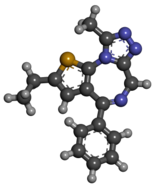Deschloroetizolam
Appearance
The topic of this article may not meet Wikipedia's general notability guideline. (September 2015) |
 | |
 | |
| Clinical data | |
|---|---|
| Dependence liability | Moderate |
| Routes of administration | Oral, sublingual, rectal |
| Legal status | |
| Legal status |
|
| Identifiers | |
| |
| CAS Number | |
| PubChem CID | |
| ChemSpider | |
| UNII | |
| CompTox Dashboard (EPA) | |
| Chemical and physical data | |
| Formula | C17H16N4S |
| Molar mass | 308.40 g/mol g·mol−1 |
| 3D model (JSmol) | |
| |
| |
Deschloroetizolam (also known as Etizolam-2) is a thienotriazolodiazepine that is the dechlorinated analog of the closely related etizolam.[1][2][3] The compound has been sold as a designer drug.[4][5]
Legal status
Deschloroetizolam is classified and controlled as a hazardous substance in Sweden as of on October 15, 2015.[6]
See also
- Adinazolam
- Clonazolam
- Diclazepam
- Etizolam
- Flubromazepam
- Flubromazolam
- Meclonazepam
- Metizolam
- Nifoxipam
- Pyrazolam
References
- ^ Karl-Heinz Weber; Adolf Bauer; Adolf Langbein; Helmut Daniel (September 1978). "Heteroaromaten mit anellierten Siebenringen, III. Umwandlung von Thienotriazolooxazepinen in Diazepine". Justus Liebigs Annalen der Chemie (in German). 1978 (8): 1257–1265. doi:10.1002/jlac.197819780806.
- ^ "Patent US 3904641 - Triazolothienodiazepine compounds". Michio Nakanishi, Tetsuya Tahara, Kazuhiko Araki, Masami Shiroki. 9 September 1975. Retrieved 13 September 2015.
- ^ "Patent EP 0776892 - Thienylazole compound and thienotriazolodiazepine compound". Yoshitomi Pharmaceutical Industries, Ltd. 4 June 1997. Retrieved 13 September 2015.
- ^ "Deschloroetizolam". New Synthetic Drugs Database.
- ^ Madeleine Pettersson Bergstrand; Anders Helander; Therese Hansson; Olof Beck (2016). "Detectability of designer benzodiazepines in CEDIA, EMIT II Plus, HEIA, and KIMS II immunochemical screening assays". Drug Testing and Analysis. doi:10.1002/dta.2003. PMID 27366870.
- ^ "Nya substanser klassas som narkotika eller hälsofarlig vara" (in Swedish). Folkhälsomyndigheten. 18 August 2015.
